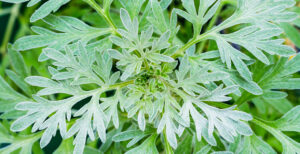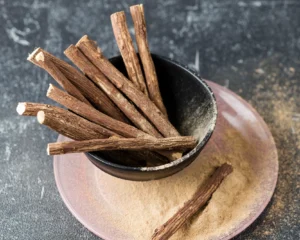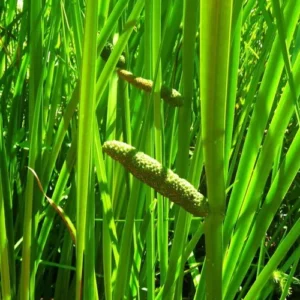Yellow Dock

Yellow Dock, scientifically known as Rumex crispus, is a perennial herb known for its distinctive long, curly leaves and deep yellow root. It is commonly found in temperate regions and is often considered a weed due to its robust growth and adaptability. Despite its weedy nature, Yellow Dock has been valued for centuries in herbal medicine for its potential health benefits. The plant is primarily recognized for its detoxifying properties and its ability to support digestive health. The roots, in particular, are harvested for medicinal use, while the leaves are occasionally used in culinary applications.
1. Size:
- Yellow Dock typically grows to a height of 1 to 4 feet (30 to 120 cm), with a spread of about 1 to 2 feet (30 to 60 cm). The plant’s tall, slender stalks and large, lance-shaped leaves make it easily identifiable in the wild.
2. Color:
- The plant has dark green leaves with a slight reddish tint at the edges. The root, which is the most commonly used part, has a distinctive yellow color, particularly when cut open.
3. Texture:
- The leaves of Yellow Dock are smooth and slightly waxy, with a somewhat crunchy texture. The root is tough and fibrous, with a hard, woody exterior and a softer, fleshy interior.
4. Fragrance:
- Yellow Dock has a mild, earthy fragrance, particularly when the roots are fresh. The scent becomes more pronounced when the root is dried and ground into a powder, giving off a slightly bitter, earthy aroma.
5. Uses:
While not commonly used in modern cuisine, the young leaves of Yellow Dock can be cooked and eaten as a vegetable. They have a slightly bitter taste, similar to spinach or chard, and are often used in soups or stews. The roots are not typically consumed due to their bitterness but are used in herbal teas and tinctures.
Yellow Dock has been used for centuries in traditional herbal medicine, particularly for its detoxifying properties. It is believed to support liver health, promote digestion, and cleanse the blood. The root is often used in tinctures, teas, and capsules as a natural remedy for skin conditions, digestive issues, and as a general tonic for overall health.
Due to its reputed detoxifying properties, Yellow Dock is sometimes used in skincare preparations to treat conditions like acne, eczema, and psoriasis. It is believed to help cleanse the blood, which in turn may lead to clearer skin.
6. Habitat:
- Yellow Dock is native to Europe but has spread to many parts of the world, including North America, where it is often found in fields, along roadsides, and in other disturbed areas. It thrives in a variety of soil types, particularly in moist, well-drained soil, and is commonly regarded as a resilient and hardy plant.
7. Cultural and Spiritual Significance:
Yellow Dock has been used in various cultures for its medicinal properties. In some Native American traditions, the root was used in poultices to treat wounds and skin irritations. It was also valued as a food source during times of scarcity, particularly for its nutritious leaves.
Yellow Dock is sometimes used in spiritual and magical practices for purification and protection. It is believed to cleanse negative energies and is occasionally used in ritual baths or smudging practices to purify the space and the body.
Spiritual Properties
Purification: Yellow Dock is associated with cleansing and purification, both physically and spiritually. It is believed to help clear away toxins and negative energies, making it a popular choice in rituals aimed at renewal and purification.
Grounding: The herb is also thought to have grounding properties, helping to stabilize emotions and bring a sense of balance and calm. It is often used in spiritual practices to enhance meditation and promote emotional well-being.
Medicinal Properties
Detoxification: Yellow Dock is renowned for its detoxifying effects, particularly on the liver and blood. It is commonly used in herbal detox formulas to support liver function and promote the elimination of toxins from the body.
Digestive Aid: The herb is traditionally used to stimulate digestion and relieve constipation. Its mild laxative effect helps to promote regular bowel movements, making it a valuable remedy for digestive health.
Skin Health: Yellow Dock is often used in herbal remedies for skin conditions, particularly those associated with poor digestion or liver function. It is believed to help clear up skin issues by promoting detoxification and improving overall health.
Iron Absorption: Yellow Dock is sometimes recommended for individuals with iron deficiency anemia, as it is believed to enhance the absorption of iron from food. This makes it a useful herb in supporting healthy blood levels.
Allergic Reactions
Yellow Dock is generally considered safe when used in moderation, particularly in its traditional medicinal forms. However, excessive consumption or use may lead to certain side effects, particularly for individuals with pre-existing health conditions.
Skin Sensitivity: Some individuals may experience skin sensitivity or allergic reactions when handling or using Yellow Dock, particularly in topical applications. Symptoms may include redness, itching, or a mild rash. It is advisable to perform a patch test before applying the herb to the skin.
Respiratory Discomfort: In rare cases, inhalation of dust from dried Yellow Dock root powder may cause respiratory discomfort, particularly in individuals with asthma or other respiratory conditions. Symptoms may include coughing, wheezing, or shortness of breath.
Digestive Disturbances: While Yellow Dock is used to promote digestion, excessive intake can lead to digestive disturbances such as stomach cramps, nausea, or diarrhea. It is recommended to use the herb in moderation, particularly in its more concentrated forms.
Low Potassium Levels: Prolonged use of Yellow Dock, particularly in high doses, may lead to low potassium levels (hypokalemia) in some individuals. This can result in symptoms such as muscle weakness, fatigue, and irregular heartbeats. It is important to monitor potassium levels if using Yellow Dock regularly.

Wormwood
Wormwood Wormwood is a perennial herb known for its bitter taste and distinctive aroma. It is a member of the Asteraceae family and is recognized

Lemon Balm & Sage Healing Tea
Lemon Balm & Sage Healing Tea An ancient blend that supports emotional healing and provides mental clarity during times of uncertainty and confusion. Ingredients: Lemon

Licorice Root
Licorice Root Licorice Root is a perennial herb renowned for its sweet flavor and numerous health benefits. It has been used in traditional medicine for

Calamus Root
Calamus Root Calamus Root, derived from the rhizome of Acorus calamus, is a well-known herb in traditional medicine and spiritual practices. Known for its aromatic

Lychee Berries
Lychee Berries Lychee Berries are tropical fruits known for their sweet flavor and distinctive appearance. They are highly valued in culinary applications and traditional medicine

Chamomile Flowers
Chamomile Flowers Chamomile Flowers are small, daisy-like blossoms known for their soothing and calming properties. These flowers have been used for centuries in herbal medicine,